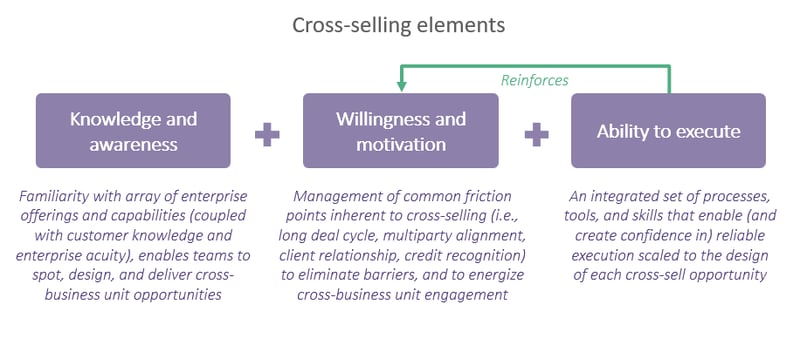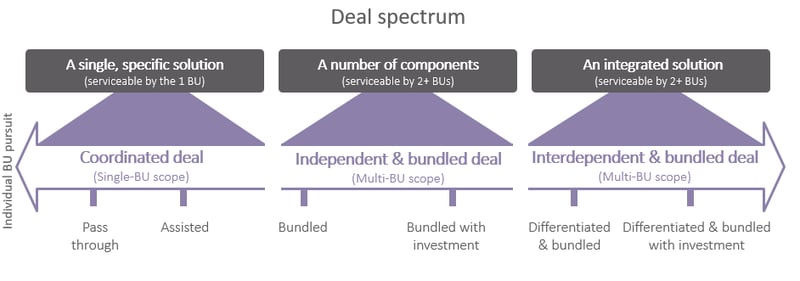
The value proposition for cross-selling is simple: combine the power of multiple offerings to deliver increased benefits for your customer and grow your share of customer spend in the process. Executing a sale across business units is rarely that simple however, and the majority of companies are unable to reliably capitalize on the tremendous opportunity available to them by better penetrating their accounts.
Why? Cross-selling is a complex activity. It brings together multiple offerings via multiple teams for a single sales objective. Internal alignment of product, sales, and delivery teams around a common objective, and executing in coordinated fashion against said objective, is often challenging. Complicating this internal alignment challenge, each sale is likely unique, solving for different issues, and delivering in different contexts (timeframe, market, client, etc.).
To manage this complexity, many companies establish rigid cross-selling processes, create specific cross-selling incentives, or empower a very small group of sales leaders to impose alignment by force of will. But none of these approaches reliably enable sales teams to spot, pursue, and execute on cross-selling opportunities across the business. Instead, replicable success in cross-selling comes from understanding and purposefully managing three elements across teams: Knowledge and Awareness, Motivation and Willingness, and Ability to Execute.

1. Knowledge and awareness
Most sales organizations preach the value of “knowing your customer” but what is often missed is the importance of also “knowing your own capabilities.” Identifying a cross-selling opportunity begins with a salesperson hearing (or just recognizing) a customer need and connecting that need to a solution the company can deliver to that customer. At a small company, or a large one with a very limited set of offerings, this connection is nearly automatic. But for a global company with multiple business units, offerings, and geographies, it’s easy for each sales team to become siloed and effectively blind to other needs their customers may have—which keeps them from being able to create or expand opportunities, and to design transformational, high-value solutions.
At large companies with multiple businesses, it is both impossible and impractical to ensure every salesperson has deep expertise in every offering. Thus, effective cross-selling requires the salesperson to play two roles: expert advisor (for customer problems addressed by their offerings), and “spotter” (for customer problems solved by other business units).
Equipping salespeople to play both roles is a balancing act. Provide too much detail on other offerings, and the information will be tuned out; provide too little, and the salespeople remain blind to potential cross-selling opportunities. One effective way to find the right balance is to review a few key customer accounts and use the experience within the accounts to understand which offerings fit together, and which should be shared broadly (based on customer type, industry, and geography). Then, use this initial mapping as a starting point for a few cross-business unit local teams (to keep the activity close to the customer) to brainstorm accounts they might approach with new offerings.
Enabling this local “joint planning” around specific accounts not only raises awareness, it builds the relationships that enable future collaboration. At the business unit level, identifying specific contacts (regionally, and by product/offering) for salespeople from other parts of the company eliminates barriers and enhances internal communication, so salespeople can see opportunities for cross-selling and know exactly how to proceed.
2. Motivation & Willingness
Knowing a different business unit could address a customer need is not enough. Each salesperson must also be motivated to pursue the opportunity, design to execution. The reality is, cross-selling usually requires more time and effort than a single-product sale, even within companies with world-class cross-selling capabilities. Thus, companies must carefully embed expectations, leadership messaging, and financial and non-financial incentives to encourage salespeople to push ahead on potential opportunities (despite added complexity or time). Otherwise, many (if not most) opportunities will not be pursued.
Establishing the right system to motivate cross-selling requires an assessment of the barriers individual salespeople perceive within your sales environment. Common barriers to entry include:
- Failing to see value in cross-selling
- Lengthening the deal cycle
- Losing control of the opportunity
- Risking the customer relationship
- Incurring a loss in the deal (due to required investment; no sales credit or compensation)
- Depending on unfamiliar (or even untrusted) parts of your company to respond to an RFP or deliver a customer solution
Mitigation of identified barriers will vary based on your organization and sales process; however, key elements of an effective system typically include a blend of: clarifying and communicating the cross-selling value proposition for the individual salesperson, for your company and for your customers; purposeful account planning to build relationships and to encourage information sharing and opportunity generation; establishing an enterprise fund to recoup losses or investments; non-financial incentives (e.g. recognition by company leaders for successful cross-sell deals); and targeted financial rewards.
Your salespeople will be motivated—or demotivated—depending on how well your organization can mitigate foreseeable barriers, and encourage collaboration with tailored organizational barriers. Get the balance right, and you create a self-reinforcing success loop; get it wrong, and you initiate the more common doom loop.
3. Ability to Execute
A customer need, knowledge in potential offerings, and motivation to cross-solve opens up value for the customer (and your company); however, there is no value without successful execution. And, an ability to execute reliably and efficiently is a key enabler of motivating individual salespeople, since nothing reduces the willingness to cross-sell in the future like a failed execution today.
Many companies seek to build discipline around cross-selling by instituting a single, often rigid, process to execute on cross-selling opportunities. This approach assumes all cross-selling opportunities are similar, or at least have many common elements. This is incorrect; customer needs and deployed offerings vary widely. It follows that solution variety warrants (and in fact necessitates) variable execution.
To illustrate, imagine two cross-sell opportunities. In the first, a customer needs a single “off-the-shelf” product, augmented by a commonly-delivered service; in the second, a customer needs a bespoke solution comprising multiple products and services, which have never been co-delivered. No single cross-selling process will provide the right level of direction and support for both opportunities. The right level for the first opportunity will be insufficient to align and execute on the second; and, the level of support required to align on and support the second opportunity will feel burdensome and slow if built into the pursuit of the first.
A better approach is to understand your company’s deal spectrum. Make an early evaluation of cross-selling opportunities (weighing the level of business unit interaction and integration of offerings), and create execution paths for major deal types.

With defined execution paths, support each opportunity with a high-level playbook and set of tools and processes for sales teams to leverage when they spot a potential opportunity. Tools should define key financial, contract, and risk parameters; help clarify roles and responsibilities during the pursuit; and manage potential tension around profit contribution. The guidance should also recognize the unique nature of many cross-sell agreements, providing a mechanism for rapidly aligning stakeholders around the proposal in any scenario.
Building clarity around execution in this way not only increases wins, it fuels the virtuous cycle that motivates salespeople to more fervently leverage cross-selling going forward.
Taking the next step
Developing and implementing the necessary awareness, motivation, and ability to execute for successful cross-selling is a process—one that will look different for every organization. Assessing your current state and developing capabilities consistent with the three key elements above, and taking a disciplined and rigorous approach to addressing any breakdowns, will enable you to strengthen your cross-selling capabilities and capture greater value and market share.
For more on this topic, visit our Sales Academy.
.png?width=512&height=130&name=vantage-logo(2).png)

